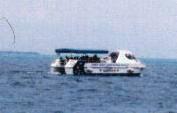Part 2: Three Days in Cancun
Introduction: In July and August 1998, the four of us took what was up to that point the most expensive vacation of our lives. This page is Part Two (of eight) of a report on that vacation. It's by far the longest of the eight installments.
This was all written back in 1998 and 1999. Other than updating links, the text below has not been brought up to date. References to "now" or "soon" or whatever are all as of 1998. Photos have been retouched, but not re-scanned -- the originals were film, not digital, and the scanner used to transfer them back in 1998 wasn't very good.
Note: I haven't bothered repeating the same link over and over, but several may be repeated from one installment of the report to the next. Usually, the first time on each page I mention something that I thought it appropriate to link, I've linked it, but after that it's generally in plain text. A few items are linked more than once; usually (but not always) these links will go different places.
We changed planes in Houston without much incident, getting lunch at the airport there because the desk attendant incorrectly told us that the flight to Cancun did not include lunch, but just a snack -- "probably a fajita." We don't like fajitas -- not even Julie, who's the least picky about food of the four of us.
Actually, lunch on the flight from Houston to Cancun was a turkey sandwich and trappings, and was pretty good, but we'd filled up on burgers at the Houston airport.
We flew on Continental, by the way. In 1990 it was Mexicana. Continental was much more pleasant, but the sample isn't statistically significant.
The sky was clear, but most of the route didn't have much in the way of scenery -- just the Gulf of Mexico, and one body of water seen from the air looks much like another. Toward the end, though, I looked out the window just in time to see the pyramid at Chichen Itza sticking up from the surrounding jungle. Thus alerted I kept a lookout, and pointed out Cancun, well off to our left, as we flew past it. The downtown area was much larger than I remembered it; the island formed a line of civilization between the lagoon and the Gulf and made a rather striking image.
(Cancun is in three pieces. "Downtown" is a bustling city of perhaps a quarter-million on the mainland of Quintana Roo. "Zona Turistica" is an L-shaped island with the short leg at the east and the long leg on the south, surrounding two sides of a triangular lagoon with an inlet at either end. The toe of the L adjoins Downtown (or Centro -- both names are used). The third piece is the airport and the access to the major highways leading down the coast or inland, on the mainland at the other end of the island. The island is eighteen kilometers long.)
We landed without incident. When we were there in 1990 the airport was quite small, without jetways, but with much construction in progress; the construction is now complete, and jetways in use.
We had filled out the required customs forms and tourist cards on the plane; we made our way through Customs, reclaimed our luggage, and found ourselves surrounded by people offering us advice, directions, transportation, and other services. I had forgotten this, but Cancun has several hundred inhabitants who support themselves by directing tourists to particular tour guides or other businesses, and getting a kickback. Or rather, a referral fee. They're not only in the airport, but in all the shopping districts, often manning "information" booths.
They're usually fairly honest about it, though, and when we explained that we were there with a package tour two different such entrepreneurs pointed us, without charge, toward the people who would provide transportation to our hotel -- a local tour company called IMC that Didion had subcontracted all the Cancun arrangements to.
IMC, also known as Intermar, had made all the arrangements for transportation in the Cancun area, and once they found us (or we found them) they snatched away the vouchers Didion had provided, took our luggage, and loaded us onto a lovely air-conditioned bus. They collected about forty of Didion's customers in this manner, then headed out of the airport toward Cancun.
The bus had a crew of two -- the driver and the guide. Our guide's name was Wilson, pronounced "Weelso'." First name. I never did get his last name. He spoke fluent but heavily-accented English, and explained to us how everything would work as far as transport between airport, hotel, and ship; he also tried to sell everyone on the bus on various tours that IMC offered.
He got a few laughs along the way. Among other things, he suggested as a mnemonic for how to find him: "I am at the Hospitality Desk at your hotel, and I represent IMC. So, remember, "I Em Seeck," and when you are sick you go to the hospital...ity desk."
Incidentally, he isn't Mexican, he's Cuban. I still don't know why his parents named him Wilson.
We were the second or third busload of Didion customers -- there'd been at least one the day before. Another was due in later that afternoon, and they'd keep coming thereafter right up until... well, the last planeload was taken directly from the airport to the ship and never saw Cancun at all. (They were also the last people to board the ship.)
A couple of people were dropped at the Ritz-Carlton -- there'd been an extra-cost option to stay there instead of the main hotel -- and then the rest of us were delivered to the Presidente Inter-Continental, where we would stay for the next two nights, and where we would be collected by IMC on Tuesday evening to be taken to the ship.
So we checked in and dumped our luggage in our rooms -- which were comfortable, but nearly at opposite ends of a long corridor. At least they were on the same floor.
No carpet -- lots of stone, tile, and concrete. This is because tropical climates are hell on fabrics. Spacious but rather stark lobby, though it had a fascinating ornamental pool.
And then we did what the kids had been waiting for -- we got into swimsuits and walked out of the hotel to the beach.
I mentioned that the Zona Turistica is an island eighteen kilometers long; well, most of it is maybe half a kilometer to a kilometer wide, and the hotels are mostly on the ocean side, right on the beach. We walked down the hall past a hotel restaurant, then past the swimming pool (with its swim-up bar) and snack bar, and we were on a Caribbean beach, with the Gulf of Mexico spread out before us in that impossible shade of blue.
I remembered that the Caribbean is very blue, much brighter than the Atlantic, but I hadn't remembered just how very blue, and how very beautiful, it is.
From our hotel's stretch of beach (which is technically federal property, but effectively the hotel's) we could see Isla Mujeres in the distance, and Cancun itself curving away in both directions. The water was bathtub-warm and calm, and we could wade out a hundred feet without even reaching shoulder depth -- it almost seemed as if we could walk all the way out to Isla Mujeres. (You can't, though; there's a drop-off a little farther out.)
Off to the left someone was parasailing, and there were various other boats zipping around.
In short, it really was like the ads. The hotel had lounge chairs under thatched umbrella-huts, and if you sat on one and didn't look either busy or asleep, an attendant would come by to take your drink order. The sun was warm and bright and golden, the sand was warm and golden, the sea was that lovely blue. It was completely relaxing.
IMC and others offered all sorts of tours, to the ruins at Tulum or Chichen Itza, or in glass-bottomed boats over the reef, or to the shopping areas; there were a zillion things we could do; but all we did was settle down on the beach, go splashing in the Gulf, and relax.
Which is the best thing about Cancun.
Eventually, after much soaking in the sun, we got hungry, went back to our rooms, changed into street clothes, and went out in search of dinner. (The hotel's main restaurant was closed, it being Sunday, and we had managed to not notice the other one.)
Had we turned left, we'd have come upon a major shopping district about a hundred yards around the curve; unfortunately, I misremembered our location and noticed that there were a couple of buildings -- a Domino's Pizza and a supermarket -- in sight to the right, and decided we should go that direction in search of eating places.
This was a mistake; we found ourselves hiking past interminable expanses of golf course, past assorted places that were not open for business either because it was Sunday or because they'd gone bust, past places that we really truly did not want to eat in on our first night in Mexico (such as Domino's), and overhead the sky began to cloud up ominously, and the weather that had been so delightful on the beach began to seem hot and oppressive after we'd gone half a mile or so.
Eventually, though, about two kilometers from our hotel, we emerged into a neighborhood where there were operating businesses, and spotted a place called El Shrimp Bucket that sported a sign reading SORRY, WE ARE OPEN. A big signboard out front had the menu posted in Spanish; I was trying to puzzle it out with my half-forgotten schoolboy Spanish when a useful employee pointed out that if I walked around to the other side it was posted in English.
Duh.
Anyway, it looked promising, so we went in and were shown to a table.
El Shrimp Bucket is built out over the lagoon, and is open to the weather on several sides. Most of the tables have buckets set into the center -- if you order a bucket of steamed shrimp, they get dumped in there. There are painted wooden cut-outs of fish hanging from the rafters, each neatly labeled (about 70% in English, 30% in Spanish, I'd estimate); the electric fish is lightning-edged and trailing a cord and plug, the Siamese fish has a tail at either end and its head in the center, etc. We had great fun spotting all the different variants.
El Shrimp Bucket calls itself "a bar and grill and clothesline," and there's a counter selling shirts, shorts, and so on; I really liked one shirt that bore the legend SHRIMP HAPPENS, but they wanted $27 for it, and I didn't like it that much.
We ordered a round of large drinks, which arrived in 18" souvenir glasses, and our dinner -- it's a pretty extensive menu, actually, lots of seafood and a reasonable assortment of other stuff. And while we were waiting for our food, it began raining.
The wait staff suddenly got very busy, folding out heretofore unseen windows to close out the wind and rain. One of the windows was only about half there; we were interested to see the young couple seated at the table next to the missing section declined to move at first.
Later, when the wind picked up and the rain started coming down in torrents and flooding the floor around them, they reconsidered, and the staff hastily stapled a couple of empty trash bags over the opening.
The food was very good, and the kids liked the decor (with the silly fish) very much, and the waiter was highly entertaining, making progressively more preposterous claims totally straightfaced -- he said he'd made the bread he brought and caught the fish Julie ordered, to start with, and worked up from there. How we got there hadn't been ideal, but it turned out to be a very pleasant dinner.
I noticed that El Shrimp Bucket belonged to Grupo Anderson, a Mexican chain specializing in bar/restaurants in tourist areas -- they're all along the U.S. border and both Mexican coasts, under various names. In Cancun they had half a dozen establishments, more than anywhere else -- besides El Shrimp Bucket, they have Carlos & Charlie's, Senor Frog, Carlos O'Brian's, Mama Roma (brand-new), and I think one more. I pointed this out to the kids, and they decided that we had to eat at Senor Frog at some point.
(Senor Frog is one of the oldest restaurants in Cancun, dating back more than twenty years. Given that the entire resort was only begun in the 1970s...)
When I got home I got curious and did a Web search on "Grupo Anderson." Their first restaurant was an El Shrimp Bucket, back in 1963, when Carlos Anderson (who died in a plane crash in 1990) was still a beach bum and not yet a hippie because hippies hadn't been invented yet. That first restaurant was in Mazatlan. There's a chronological list of their restaurants on their Website.
Someone is planning to open a Senor Frog in Las Vegas, and Grupo Anderson is suing on several grounds, trademark infringement being only the most obvious. The only legitimate Anderson restaurant north of the border is a Carlos 'n' Charlie's in Lake Travis, Texas, which I think is near Austin. There are Anderson restaurants in Madrid, Barcelona, London, etc.
Oh, wait -- there may also be a Carlos 'n' Charlie's in Orlando; it's listed under "opening in 1997." (I think they need to update their Website.)
Note, 2015: Almost everything in the preceding three paragraphs is out of date. Grupo Anderson is still active, but their brands and locations have changed.
Anyway, they're a large, successful international chain, and their late founder, Carlos Anderson, appears to have been one of the classic eccentrics of our time -- he once took a fancy to a cab driver and hired him, first as a chauffeur, then as the manager of his first Mexico City establishment.
After we ate it was still pouring, so we weren't about to walk back, and we hadn't yet changed any money so we couldn't take the bus. Cabs, however, will take dollars, so we flagged down a cab and rode back to our hotel.
I note that in 1990, one was expected to dicker with cab drivers, and the opening offer was usually about 2,000 pre-revaluation pesos, or about 70c, above what one wound up paying. Now, though, that's gone -- the driver gives a price, and that's what you pay. (There are no meters -- and you agree on the price before you get in, or you're asking to be swindled.)
Also, in 1990 the cabs in Cancun were mostly VWs; now they're mostly Nissans.
And then followed a quiet evening in the hotel -- we were all pretty tired out -- and to bed.
For our second day in Cancun Julie and I were determined to get to Downtown for some shopping, whether the kids wanted to or not, but we weren't in any great hurry; we had no objection to the kids spending the morning on the hotel's stretch of beach. Julie accompanied them, but I did some reading and planning instead, making arrangements for the one actual tour we were planning on (of which more anon).
For lunch we left the hotel, but this time we turned left instead of right, and found ourselves at the north end of the main shopping district of the Zona Turistica. The main highway splits there, going on either side of a couple of malls and assorted shops, and that central area includes some pedestrians-only streets and a small central square, which was where we found a pleasant little sidewalk cafe.
Oh, I forgot to mention breakfast -- we looked at the menu at the hotel's Flores y Frutas restaurant, but then decided to just grab some pastry and beverages at the supermarket a block away. I had to change some money to pesos to accomplish this, but there was a cambio offering a decent rate in the same block. (Rates vary. At the airport one could get 8.5 pesos to the dollar; elsewhere we saw as low as 8.3 and as high as 8.85, and the place I used was offering 8.6. I understand that just in the two weeks since we were there the peso has slipped badly.)
We got ourselves a package of sticky buns, assorted drinks, and a bunch of bananas for 25 pesos, and ate a pleasant little breakfast. The cheapest item on the hotel's breakfast menu was 30 pesos.
One really can eat cheaply in Cancun.
The cafe where we had lunch was nowhere near so cheap, of course, but it wasn't bad, and the food was excellent. In general, the food in Cancun was very good this trip, where in 1990 it was unreliable. The one thing you can't get, then or now, was a decent burger; this did not bother us at all. Seafood and chicken are the way to go -- especially shrimp, because hey, you're on the Gulf of Mexico, fer pete's sake.
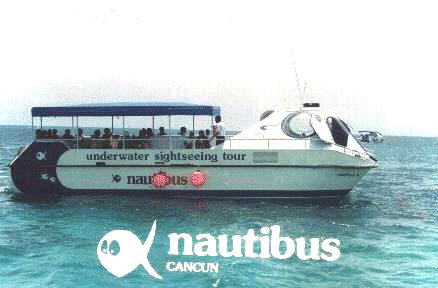
And then after lunch... well, when we were in Cancun in 1990, one particular ad caught my fancy, and we gave it a shot. It turned out to be a highlight of the trip, so we were resolved to do it again, and that morning, while the others were at the beach, I'd bought tickets.
I refer to the Nautibus.
Between Cancun and Isla Mujeres is a coral reef -- the second-largest in the world, after Australia's Great Barrier Reef. It's about 600 kilometers long, if I heard correctly. Naturally, scuba divers and snorkelers go out to visit it, and so do glass-bottomed boats of various sorts.
There are now several such boats, including at least one genuine submarine, but the Nautibus was the first, and in 1990 the only. The Nautibus is a twin-hull catamaran; the sides of both hulls are glass, and seats are provided. One rides up top until the boat's out over the reef, then goes down into one of the pontoons and looks out at the fish, coral, and so on.

Anyway, we remembered the Nautibus fondly, and intended to ride it again. Our tickets were for 2:00, so there was no great rush, and after lunch we drifted back to the hotel in no great hurry to regroup. From there, following Wilson's directions, we headed for the Nautibus at Playa Tortugas.
Wilson had misled us; he said it was less than a mile, maybe ten minutes walk, fifteen at the outside. It was two kilometers, and took a little over twenty minutes. If we'd known that we'd have caught a bus. Fortunately, we'd allowed extra time and reached the dock at Playa Tortugas in plenty of time.
Last time the Nautibus had been running out of a businesslike wharf at the North Inlet, next to a small restaurant but away from just about everything else; now it runs from a dock adjoining a beach, and is surrounded by merchants' stalls and other attempts to pry money from tourists' pockets -- a bungee jumping rig, for example (though it didn't seem to be operating). There's a much larger restaurant/bar/nightclub nearby, too -- Fat Tuesday.
And there are two Nautibi now. We were on Nautibus II. The two were indistinguishable except for the numbers on the sides.
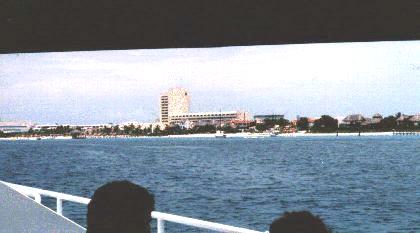
Also, in 1990 the Nautibus advertised an on-board party on the way out to the reef, and beer and soda were dispensed freely once the boat was moving; in 1998 there was no mention of a party and no beer, just Coke. It's possible this is a seasonal/cultural thing, or maybe the party atmosphere has been transferred to the newer craft, such as the Atlantis.
Seasonal... in 1990, Cancun catered almost entirely to foreign tourists, mostly Americans, but with a smattering of Canadians, Brits, Brazilians, and Japanese. That's changed. In the winter it still relies on foreigners, but in the summer the largest category of tourists is Mexicans -- they go to the beach there just the way Americans go out to Ocean City or the Barrier Islands or Cape Cod.

(Norteamericanos seem to think that Cancun must be unbearably hot in the summer. It really isn't -- it's hot, but by no means unbearable.)
Summer used to be the off season; now it's the domestic season. This is definitely an improvement. It does mean, though, that the nightlife is wilder and the party atmosphere more prevalent in the winter, when American college kids outnumber proper Mexican families. So maybe that's why the Nautibus didn't serve beer any more, I dunno.
Incidentally, Japanese tourists were few and far between -- their economic woes are hurting Cancun. I understand Hawaii's been hit much harder, though.
We did see American, German, English, Canadian, and Brazilian tourists. And lots of Mexicans.
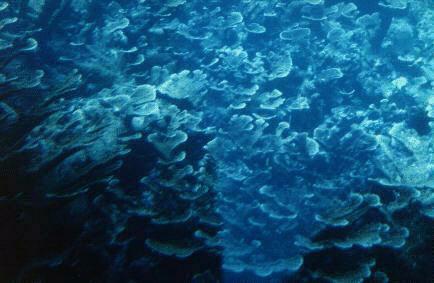
Anyway, we cruised out to the reef, then went below and marveled at the fish and coral. Because it was summer, the informative announcements were only made in Spanish -- last time they'd been in both Spanish and English, I think. I know enough Spanish that I caught bits here and there; there was a Japanese family in our pontoon who looked completely lost. (The only Japanese family I remember seeing on the entire trip, by the way.)
I'd like to give some description of the reef and the fish, but I don't know what to say. It's gorgeous. Scads of fish in great variety -- the most common sort is a little larger than my hand, vertically striped and iridescent. The Nautibus cruised over it for perhaps half an hour, and it looked (probably deceptively) as if we were clearing the coral by just a foot or two much of the time. The water in that area is amazingly clear, and we could see perfectly.
I liked the 1990 Nautibus tour better, as I liked having party music on the way out to the reef and there was greater novelty, but the kids preferred the 1998 trip. I was worried it would be a disappointment, not living up to nostalgic memory, but I needn't have been.

On the way back to port we stayed down in the pontoon most of the way, even after we left the reef. There's not much living on the sand, so it wasn't all that exciting, but we did see a couple of rays.
Back on land we bought a couple of souvenirs from one of the stalls -- a couple of brightly-painted, hand-carved wooden animals -- then boarded an R-1 bus headed for Downtown.
About the buses: In 1990, the buses in Cancun were decrepit, forbidding things painted an ugly green that looked rather like World War II leftovers. The locals used them, but tourists did not; tourists used the ubiquitous taxis (which were also mostly green, but a nicer shade).
In 1998 there are fewer taxis, but the buses are far more numerous and far more modern, and the guides recommend the buses to tourists. Both buses and taxis are now mostly painted white; the taxis have green stripes, while the buses mostly have ads.

Bus fare to anywhere is four pesos, pay as you enter, and they'll make change only if it can be done in Mexican coinage -- no bills, no U.S. currency, and if all you have is a $20 bill that's tough, you get no change. Mexican coins theoretically go to 20 pesos, but the largest we saw, and I think the largest they have on the bus change racks, is 10.
The bus drivers mostly know some English, but it's not required, and I don't think they have to accept dollars at all if they don't want to. Hey, I won't complain about that. The taxis now take dollars, which they didn't all used to.
In general, in 1990 you wanted most of your money in pesos; in 1998 dollars are good just about everywhere, but you can usually get a slightly better price in pesos, and there are a few things -- like buses and supermarkets -- where pesos are essential.
The R-1 bus runs from the center of Downtown out through the entire length of the Zona Turistica, and then back. One sometimes saw other buses in the Zona -- R-2 and R-5 in particular -- but we avoided those, as we didn't know where they went, and the R-1 we understood.
So we climbed aboard, I told the driver "cuatro" and handed him a 20-peso note, he gave me two 2-peso coins in change and a handful of tickets (which are completely useless, so far as I can see, unless someone accuses you of not having paid), and we were off.
As we rode into Downtown I tried to spot landmarks from our 1990 trip, and was startled by how few I recognized -- Cancun has grown immensely in eight years, and turned into a real city.
In fact, the entire coast of Quintana Roo has boomed. I don't remember the exact Spanish, but everything from Cancun to Tulum is now considered a tourist area. (Tulum is a ruined Mayan city -- the only one built right on the sea, and with walls, and other oddities -- about midway between Cancun and the Belize border.) The lagoon and ruins at Xel Ha ("Ha" is Mayan for "lagoon," more or less) have been developed into a whole park, apparently -- we visited there in 1990 and marveled at the incredibly-clear water, and while we didn't go back this time, we saw enough maps and ads to be certain it's been built up considerably.
And there's an entire new complex called Xcaret (pronounced "esh-carette") midway between Cancun and Xel Ha now -- a sort of ecologically-sound amusement-park-cum-nature-preserve. We didn't get to that, either, but it's apparently a Big Deal. One can ride a raft on an underground river (Quintana Roo sits atop limestone that's laced with caves and aquifers and sinkholes), see exhibits about the Mayans and the local wildlife, and so on. IMC offered a tour that ran from the Presidente Inter-Continental to Xcaret, and then from there directly to the Leeward, which about 200 people took -- but we didn't; we were deliberately sticking to low-stress, minimal-effort stuff, not taking tours.
Playa del Carmen appears to be developing into a sort of secondary resort/port, as well. None of this was going on a decade or so back.
Some of the rural Third-World charm is definitely fading from the area -- but the beaches and ruins aren't being touched, the food and services are improving greatly, and it's really a bit hard to get upset about a lot of scrub jungle, previously used for slash-and-burn subsistence agriculture, being replaced by a thriving tourist economy.
Note that the aboriginal rain forest was wiped out by the Mayans about 800 years ago.
Anyway, Downtown Cancun has boomed. It used to be that most of the businesses were in a few blocks along the main drag; now they're all over.
We did eventually spot some landmarks, and disembarked a couple of blocks from our intended destination. It used to be simply called "the market"; now it's "the Downtown flea market." It's a concrete complex of market stalls. At first glance it doesn't look like much, but once you're inside you discover that it keeps going and going and going, through shop after shop, around courtyards and passages.
I have no idea how many small businesses are crammed in there, but it's dozens, maybe hundreds. One sees a lot of the same things over and over -- T-shirts, onyx chess sets, and so on -- but there are also lots of curiosities. And where most of the regular stores now operate on the pay-the-marked-price system, here it's all still haggling and dickering.
We got Julian a T-shirt, and Kiri a necklace. We hadn't actually intended to get Kiri a necklace, but the shopkeeper saw her looking at it and started talking, insisting it was "almost free," that he'd give us an unbelievable price.
He asked 400 pesos -- I suspect he thought we weren't too clear on how much that was. It was obvious to everyone, as we had begun to realize, that we hadn't been in town more than a couple of days -- our skin was too pale. We weren't interested at that price (almost $50) and started to leave, whereupon it dropped to 350 pesos. We still weren't interested, and he insisted we make an offer.
Julie said we didn't want to insult him by offering what we were willing to pay -- which is, of course, exactly the right thing to say, though I don't know if Julie meant it that way. He insisted we make an offer.
I said we couldn't pay more than 100 pesos -- and he took it. Which surprised the heck out of me; I thought we'd wind up at 150 or 180.
It's a nice necklace.
We picked up a few other minor odds and ends, had a snack, fended off various other merchants -- I was addressed as "Mr. Whiskers," "Senor Ponytail," and "Mr. Hair" by various people; I didn't really mind the first two that much, but "Mr. Hair"? I hadn't realized that bearded, long-haired tourists were as unusual as all that, but apparently we are.
Eventually we worked our way through the flea market -- and no, we hadn't seen anywhere near all of it, but we'd come out the other side and had enough, and moved on to the surrounding shops, paying special attention to the ones with working air conditioning, as it was hot.
By the time Julie had had enough of shopping -- which was slightly after me, and well after the kids -- it was getting on toward suppertime, by our standards. Mexicans seem to consider anything before 7:00p.m. to be "lunch," but we were ready for dinner somewhat before 6:00. Wilson, back at the hotel, had referred us to a place called Carrillo's, which is a bit off the main drag, and had given us directions and written us a chit for a free drink (which presumably got him a kickback). We found it without difficulty and ate there.
It's a bit expensive for Cancun, and we got a table in a back corner that wasn't particularly thrilling, but the food was good. And to be fair, we got that table because we wanted something indoors, with air conditioning, and all the best tables are on the patio.
Oh, the other drawback is that they don't take charge cards (which seems very odd) and require ID for travelers' cheques.
It was too early for most people, so it was mostly empty.
Kiri had beer-batter shrimp and discovered that she loves beer-batter shrimp. I ordered fried chicken and discovered that in Cancun "fried chicken" doesn't mean "Southern fried chicken." It means Mexican-style fried chicken -- skinless chicken breast, no breading, pan-fried in some sort of seasoning, blackened around the edges. Good, but not at all what I'd expected.
After that we got the bus back to our hotel. Cancun's famous for its nightlife, but you wouldn't know it by us -- we just hung out at the hotel in the evening.
And the next day was Tuesday, our last day in Cancun, a day we had set aside to do touristy stuff.
We spent Tuesday morning much as we had Monday -- a cheap breakfast from San Francisco de Asis, a couple of hours on the beach, then heading over to the shopping district for lunch.
This time we wound up eating at a fancy Italian place in a modern shopping mall -- not the fanciest Italian restaurant in that particular mall, either. We ate in a greenhouse area, which was sunny and pleasant, but air-conditioned.
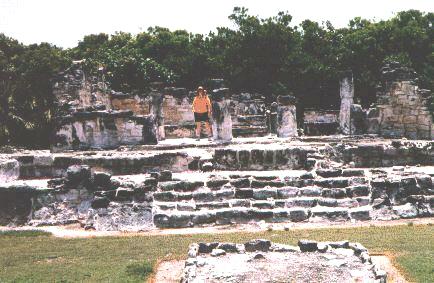
When we'd eaten our fill and seen all we wanted of the local shopping, we caught a taxi for our next stop: Las Ruinas del Rey. After all, one really can't visit Quintana Roo and not look at any Mayan ruins; it's just not done.
Las Ruinas del Rey is all that's left of the original Cancun. Cancun was a Mayan fishing/market village for several centuries; the original town center was abandoned after the empire fell, but the village remained, and remained a village until the Mexican federal government chose the island as the site for their big Atlantic resort project in the 1970s. "Cancun" is Maya -- "can" means "snake" or "serpent" (as in Kukulcan, the feathered serpent), and "cun" means "home" or "nest." The official tourist brochures lie about the name, making up various translations rather than admit it means "snake's nest," but that is what it means, and it wasn't derogatory at all, as the Maya were herpetophiles.
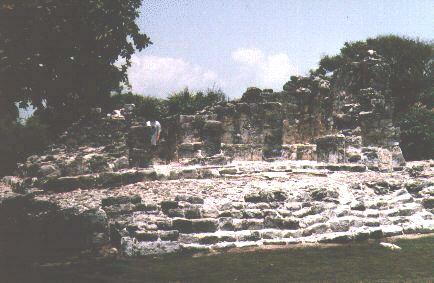
Anyway, back in imperial times, Cancun had a priest-king and a proper town center. That was all long since lost in the jungle by the 1970s, but when the resort was started the feds also set about uncovering the ruins, and by 1990 they were open to visitors. We visited them, and found them rather charming. The central complex of pyramid, market, and temple had been uncovered ("excavated" doesn't seem right -- they weren't buried underground, just under jungle), and for a modest fee we were admitted and had a good time climbing around and watching the iguanas (of which there were many hundreds).
At the time the ruins were well off the highway, surrounded by jungle, accessible by a potholed dirt road; the only modern structure was a small wooden booth at the entrance where one paid the admission fee, and there were far more tree-climbing land crabs than human beings.
This year, when we went back, we had expected to find more or less the same thing. We didn't.
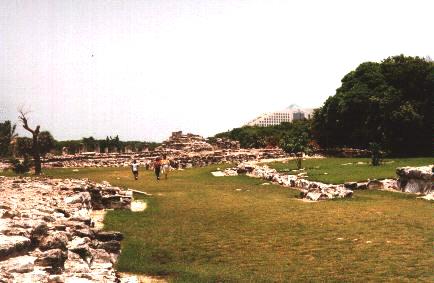
In 1990 we had taken a cab to get to the ruins, and the driver was kind enough to wait for us. We'd expected to do the same thing this time, so we boarded a cab and were whisked to Km. 17 -- and discovered that the main highway has been re-routed, and now passes no more than a hundred feet from the ruins. You still can't see them from the highway because of the intervening greenery, but once dropped off there was no access road, but merely a flight of stairs (the highway is somewhat elevated) and a short path. The admission booth has been replaced by a much larger one in a different location. The land crabs are gone; the iguanas are reduced from hundreds to dozens; and much of the surrounding jungle has been cleared away. The ruins are now in a fairly narrow strip between the highway and a new golf course.
On the other hand, they've excavated the entire village, rather than just the central complex -- there are wide avenues running north and south from the pyramid that were lost in the jungle in 1990, both of them lined with ruins.
Most of the ruins are just foundations and steps, since Mayan homes and buildings of lesser importance were generally built of wood on a stone foundation and floor, but you can now see the layout of the entire town, and get a feel for how the Mayans lived there.

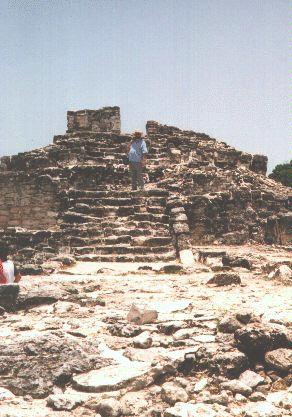
And the central complex is still neat. There's the pyramid on the east -- very steep, about twenty feet high -- the market on the north, and what's believed to have been the town hall/administrative center/temple on the south. All the roofs are long gone, but most of the pillars -- at least the bases -- are still there.
It's nothing much compared to the ruins at Tulum or Chichen Itza, but it was enough ruin for us, and we had a lovely time climbing around on everything, reading the markers (which are in several languages), watching the iguanas (there was a big one on the base of the pyramid), and so on.
But it was a very different experience from 1990 -- the jungle's all been cleared away!
(I have a few more pictures of the ruins than I can comfortably fit here; click here to see more of the ruins.)
After that we were all hot and thirsty, and crossed the highway looking for somewhere to get a drink. The only structure close by is a hotel called El Pueblito, atop a hill; we climbed up to it, and discovered that the hotel bars and restaurants were all restricted to hotel guests, but we were able to buy cold drinks from the hotel gift shop and drink them in the atrium before being shooed away.
I'd never before encountered a hotel that operated that way. We noticed that it catered almost exclusively to Europeans -- is that a common set-up in Europe, perhaps?
When we felt a bit less dehydrated, we went back down to the highway and caught a good ol' R-1 bus back to our own hotel. Our next event was something we'd promised Kiri.
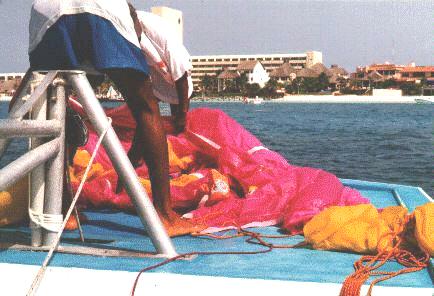 And I had my doubts about trying it because (a) I'm large and heavy, and (b) I don't swim well at all.
And I had my doubts about trying it because (a) I'm large and heavy, and (b) I don't swim well at all.
She wanted to go parasailing.
So had Julian originally, after seeing the parasailers, but he'd developed a bit of an upset stomach that we thought came from his lobster-tail sandwich at lunch -- we think it was cooked in butter, and Julian's allergic to milk protein. Whether it was the lobster or not, he felt sufficiently queasy that parasailing didn't seem like a good idea.
I'm not sure why Julie didn't give it a try, but she didn't. It was just Kiri.
The hotel had a water-sports concession on the beach that offered wave runners, snorkeling, and all the usual stuff -- including parasailing, at the going rate of $35 for ten minutes in the air. So we didn't even need to go anywhere.
Kiri loved it; she said it wasn't scary at all. Had a wonderful time. I wish I'd tried it; next time I will. Hell, if we'd had more time in Key West I'd have tried it there -- there they charge $35 for fifteen minutes. Kiri barely even got her feet wet, and wouldn't have gotten them wet at all if the boat crew hadn't included practical jokers who deliberately bounced her as they were reeling her in.
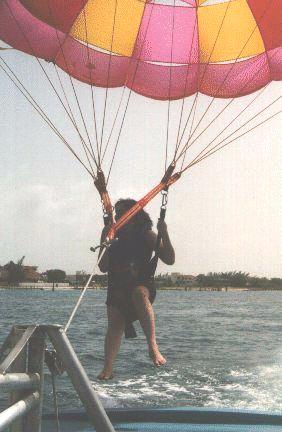
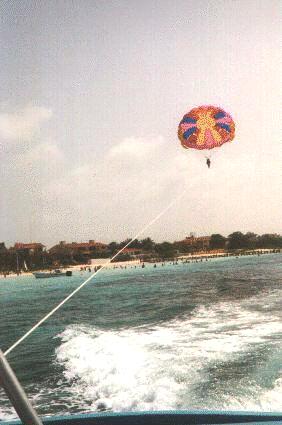
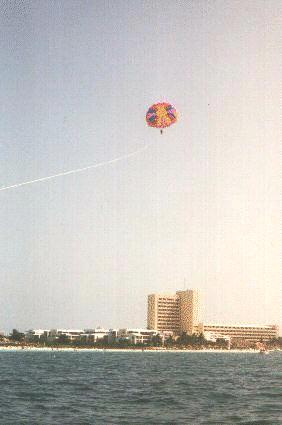
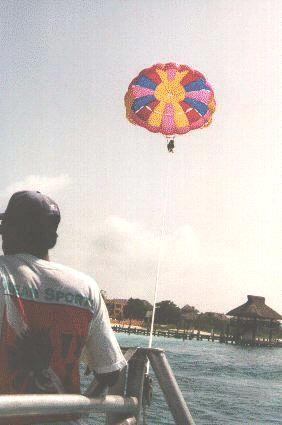
Parasailing was invented as a variant on water-skiing -- in Acapulco, I believe -- but they long ago discarded the skis as superfluous. It's really kite-riding from the back of a boat, and zero skill is involved. They use big colorful parachutes, not hang gliders, everywhere I've seen it done. I'm told you can reach an altitude of 600 feet; I don't think Kiri went anywhere near that high.
And that completed a busy afternoon; after everyone was dried off and dressed we caught a bus and headed, per the kids' request, to Senor Frog's for dinner.
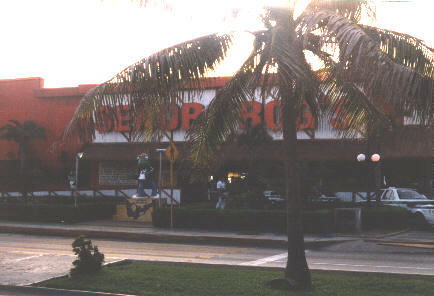 Senor Frog's is the second-rowdiest of Grupo Anderson's establishments in Cancun, after Carlos 'n' Charlie's; although we were eating there at the kids' insistence, I half-expected them to decide it was too rowdy.
Senor Frog's is the second-rowdiest of Grupo Anderson's establishments in Cancun, after Carlos 'n' Charlie's; although we were eating there at the kids' insistence, I half-expected them to decide it was too rowdy.
They didn't. Julian did allow afterwards as he'd have liked it better if it weren't quite so loud, but they both enjoyed it.
The walls are adorned with humorous posters of various sorts -- to paraphrase a couple: "All our waiters answer to 'darling' or 'precious,"' and "Occupancy by more than 312 persons is dangerous and unlawful and really unlikely."
There's a big drawing on one wall of "the amazing Spider-Frog," signed by Johnny Romita.
There's a slide that starts from the second floor, goes through the main dining room over people's heads, out a window, and into the lagoon; we didn't see it used, though.
One waiter's shirt read, "I don't know English, but I promise not to laugh at your Spanish."
The whole place is somewhat ramshackle. They take the food seriously, though -- it was excellent.
The music was loud; the staff occasionally interrupted service for performances of one sort or another. The party atmosphere can be a bit overwhelming.
At one point a conga line of waiters blowing whistles emerged, a big glass bottle balanced atop the leader's head -- a bottle with a spout and full of something red. This red substance was poured into a customer's mouth amid much cheering until she gurgled and closed up, whereupon the parade moved on to another victim.
I was third or fourth. I don't know what the red stuff was, but it tasted darn good, and I'm pretty sure it had tequila in it. I got less in my beard than I feared.
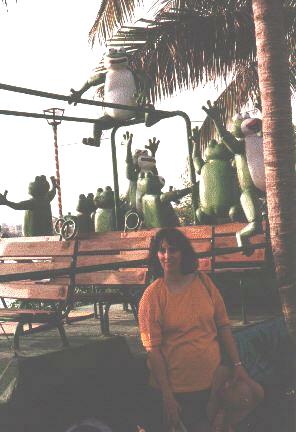 After dinner we tottered out -- I admit to being a bit tipsy, but only a bit -- and began walking back toward our hotel. We hadn't decided whether to walk the whole way (a little over a mile), or just partway and then grab transportation, but it was too nice a night to get on a bus or in a cab right away.
After dinner we tottered out -- I admit to being a bit tipsy, but only a bit -- and began walking back toward our hotel. We hadn't decided whether to walk the whole way (a little over a mile), or just partway and then grab transportation, but it was too nice a night to get on a bus or in a cab right away.
The trip took us through the main shopping district in the Zona Turistica, and we wound up walking the whole way. Julian decided after we'd gone most of the way that he was tired and wanted to ride, but by then we were so close that I just pointed out recognizable buildings ahead -- we weren't quite in sight of the hotel. He looked at them, took a minute to think about them (he hadn't seen them from this side and distance before), and said, "Is that where we are? Never mind."
So we got safely back to the hotel, got our luggage out of storage (we'd checked out that morning), and hung around the lobby. Our bus to the ship was supposed to leave at 9:30.
The hotel lobby was mobbed with people waiting to get transported to the Leeward -- there was a big sign saying "Didion World Cruises Welcomes You" or something similar hanging over the bar, and scads of people clustered around it. After a few minutes the kids decided it was too crowded, so they and I went up to an upstairs lounge area we knew about, leaving Julie and our luggage in the lobby to keep an eye on things. I figured we'd head back down about 8:45.
About 8:40 Julie came up and told us worriedly that a line had formed and was moving rapidly and we should get back downstairs, so we did.
There was a line, all right, running down one side of the huge lobby and into the bar, but it wasn't moving any more, and we didn't want to stand in it. Instead we sat in the lobby and watched.
It didn't move for quite some time.
I noticed a couple of people with uniforms and nametags near the door, and went to talk to one of them. I forget her last name, but after reading her tag we dubbed her Lynnette the Helpful Person. She explained that the hotel parking lot was so small they could only fit two buses in it at a time, and there were twelve buses (at 45 people apiece). (That's 540 people. Another 200 or so were at Xcaret, a busload or two would be coming straight from the airport, and a busload was at the Ritz-Carlton. This leaves a few unaccounted for, but presumably they all got to the ship somehow. Or maybe Didion hadn't sold all 900 berths, I dunno.)
The line had formed when she had announced that the first two buses were loading. It was supposed to have dispersed until the next two were ready, but hadn't.
I asked if there was any point to standing in line at this point. "None at all," she said. So we didn't.
Our luggage did disappear somewhere about this point -- it was loaded onto one of the buses, properly tagged, and we didn't see it again until we got to our cabins aboard the Leeward.
Lynette, incidentally, worked for IMC, not Didion -- she had settled in Cancun a couple of years before, but was from the U.S. originally.
The mob in the lobby gradually thinned as buses were loaded. I bet the hotel was just thrilled by all this -- most of these people had arrived that day and not had rooms; they'd just hung around the hotel, not paying anything.
Eventually the line shortened to less than a busload, and we decided it was time. We stood in line for maybe three minutes, and at about 10:00 we were finally loaded onto a lovely air-conditioned bus -- about #10 or #11 out of the twelve. #11, I think. We were seated way at the back.
On the bus out of Cancun Kiri and I were seated on one side of the aisle near the back, Julie and Julian on the other. We watched the scenery go by for awhile, but once we were well clear of the city there wasn't any scenery -- just miles and miles of unlit scrub jungle, with maybe an occasional palapa in the distance. And it was a fairly long ride -- we'd heard it was an hour or so, but an hour and a half was closer to the truth.
(Side-note: Cancun is on Central time, but Quintana Roo didn't have Daylight Savings Time; CST is the same as EDT, so we never changed time, unless you count the stopover in Houston. Q.R. is going to have Daylight Savings, though -- in fact, I believe the switch was made while we were in the Bahamas...)
So we got bored, and talked, and Kiri and I discussed Circulism, the New Age mystic religion Kiri's invented. We're seriously considering collaborating on a book about it. She's not serious about it, it's just for fun, but why should that stop us from making a buck?
It came up because we were looking at the moon -- Circulism has some very interesting theories about the phases of the moon. Did you know traditional beliefs have it all wrong? The full moon doesn't cause werewolves; werewolves cause the full moon.
Anyway, at long last, when we were beginning to wonder where the hell we were going, the bus turned off the highway and lumbered down a not-very-good road past some minor industrial stuff, and ahead of us we glimpsed something big and lit up, something golden-cream in color.
As we got closer we saw it was definitely a ship.
It looked huge.
The bus wiggled its way around some fences into an unloading area, where it stopped, and we were given instructions. We would finally need the paperwork we'd accumulated -- the tickets Didion had sent us back in June, the tourist cards we'd filled out on the plane from Houston, our passports or other proof of identity, and so on. We would be running a gauntlet of red tape from the parking lot to the ship -- first the tourist people making sure we had our papers, then Mexican immigration confiscating our tourist cards, then Norwegian Cruise Line people checking us in.
And thus it was. The first checkpoint was at the exit from the parking lot; then down a few yards of sidewalk to an open-sided tent, where to get into the tent we had to turn in the tourist cards (which aren't cards, by the way, they're slips of paper). Inside the tent there was a supply of terrible drinking water and some sort of uninteresting munchies, and lines of NCL people. The wait was brief; in maybe two minutes I was handing a nice lady our tickets and passports, and receiving boarding passes and our cabin keys in exchange.
I was a bit startled to not get the passports back, but it turns out that the cruise line bulk-processes them through U.S. immigration, at a vast savings in time and line-standing.
Equipped with boarding passes we left the tent, went down across a broad stretch of concrete, up a gangplank, and aboard ship, on what we discovered to be Deck 3. There our picture was taken, Julie and I were handed souvenir glasses holding fancy tropical drinks -- only later did I realize we'd be billed $5.95 plus 15% gratuity for each -- and we were directed aft, toward our cabins.

That first experience of the ship was impressive. It's actually white, and the golden-cream color came from the lighting; the entire thing was lit up, with banks of floodlights mounted along the promenade on Deck 5. When we walked out to the gangplank the ship loomed over us spectacularly; we couldn't see the upper decks, just this huge wall of painted metal and assorted windows. The gangplank entered through a doorway two stories high and about ten feet wide -- the two stories are Deck 2 and Deck 3; we were entering on the higher level.
And once inside we were surrounded by carpets and gleaming brass. The entry, and the passageway aft, weren't very much, but then we got to the aft stairway...
Glass elevators. Grand staircases with brass handrails. A stained-glass ornament between the staircases that ran some six or seven storeys, top to bottom.
This was what a cruise ship was supposed to look like!
We rode one of the glass elevators to Deck 6, and rounded the corner to port, and there were our cabins, just where they were supposed to be. #6112 had a king-sized bed, while #6113 had two singles, so there was no question of who would sleep where. The keys worked. Our luggage was waiting for us in the passageway -- nothing was missing, everything just as it should be.
We were finally aboard.

This concludes Part Two. Links to the other parts of this trip report are below:

- Planning and Departure. (Previous installment)
- Cozumel. (Next installment)
- Across the Gulf of Mexico.
- Key West
- Great Stirrup Cay
- Port Canaveral and the Kennedy Space Center.
- Charleston, Alexandria, and home.




